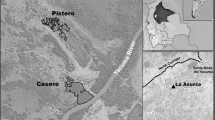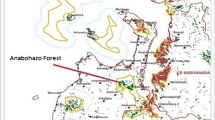Abstract
Food handouts from visitors to Mt. Emei, in The People’s Republic of China, have considerably increased the diversity of food available to an indigenous population of Macaca thibetana.Some 43% of the feeding time was spent at the trail area frequented by tourists. Ranging behavior was of two kinds: wandering around within the group’s most densely used areas and making peripheral excursions between the areas. Three kinds of trail-area use were observed: three-group overlapping, two-group overlapping, and exclusive. M. thibetanatended to use sheltered sites for sleeping, to ensure safety and/or to keep dry in a rainy habitat. Exclusively and successively used sleeping sites were noted. The average size of the home range per group was 3 km 2; the average population density for the entire range was 13/km2, and the biomass was 109 kg/km2. The population may be growing, a possibility that is also supported by previous analyses using data on group composition.
Similar content being viewed by others
References
Altmann, S.A., and Altmann, J. (1970).Baboon Ecology: African Field Research, University of Chicago Press, Chicago and London.
Clutton-Brock, T. H. (1975). Ranging behaviour of red colobus (Colobus badius tephrosceles) in the Gombe National Park.Anim. Behav. 23: 706–722.
Clutton-Brock, T. H., and Harvey, P. H. (1977). Species differences in feeding and ranging behaviour in primates. In Clutton-Brock, T. H. (ed.),Primate Ecology, Academic Press, London, pp. 557–584.
DeVore, I., and Hall, K. R. L. (1965). Baboon ecology. In DeVore, I. (ed.),Primate Behavior: Field Studies of Monkeys and Apes, Holt, Rinehart and Winston, New York, pp. 20–52.
Dittus, W. P. J. (1977). The socioecological basis for the conservation of the toque monkey (Macaca sinica) of Sri Lanka (Ceylon). In H. S. H. Prince Rainier III of Monaco and Bourne, G. H. (eds.),Primate Conservation, Academic Press, New York, pp. 237–265.
Fittinghoff, N. A., Jr., and Lindburg, D. G. (1980). Riverine refuging in East BorneanMacaca fascicularis. In Lindburg, D. G. (ed.),The Macaques, Van Nostrand Reinhold, New York, pp. 182–214.
Fooden, J., Quan, G.-Q., Wang, Z.-R., and Wang, Y.-X. (1985). The stumptail macaques of China.Am. J. Primatol. 8: 11–30.
Homewood, K. M. (1978). Feeding strategy of the tana mangabey (Cercocebus galeritus galeritus) (Mammalia: Primates).J. Zool. (London) 186: 375–391.
Hu, J.-Z. (1981). Mammalia. In Shi, B.-N., and Zhao, E.-M. (eds.),Sichuan Fauna Economica, People’s Press of Sichuan, Chengdu, Vol. I, pp. 78–96 (Chinese).
Itani, J. (1975). Twenty years with Mount Takasaki monkeys. In Bermant, G., and Lindburg, D. G. (eds.),Primate Utilization and Conservation, Wiley-Interscience, New York, pp. 101–125.
Kawamura, S. (1975). The present situation of Japanese monkeys and consideration of their conservation. In Kondo, S., Kawai, M., Ehara, A., and Kawamura, S. (eds.),Proc. Symp. 5th Congr. Int. Primatol. Soc., Japan Science Press, Tokyo, pp. 159–169.
Kummer, H. (1968).Social Organization of Hamadryas Baboons, University of Chicago Press, Chicago.
Lindburg, D. G. (1977). Feeding behaviour and diet of rhesus monkeys (Macaca mulatto) in a Siwalik forest in North India. In Clutton-Brock, T. H. (ed.),Primate Ecology, Academic Press, London, pp. 223–249.
Makwana, S. C. (1978). Field ecology and behavior of the rhesus macaque (Macaca mulatta). I. Group composition, home range, roosting sites, and foraging routes in the Asarori forest.Primates 19: 483–492.
Neville, M. K. (1968). Ecology and activity of Himalayan foothill rhesus monkeys (Macaca mulatta).Ecology 49: 110–123.
Simonds, P. E. (1965). The bonnet macaque in South India. In DeVore, I. (ed.),Primate Behavior: Field Studies of Monkeys and Apes, Holt, Rinehart and Winston, New York, pp. 175–196.
Southwick, C. H., Beg, M. A., and Siddiqi, M. R. (1965). Rhesus monkeys in North India. In DeVore, I. (ed.),Primate Behavior: Field Studies of Monkeys and Apes, Holt, Rinehart and Winston, New York, pp. 111–159.
Wada, K., and Tokida, E. (1981). Habitat utilization by wintering Japanese monkeys (Macaca fuscata fuscata) in the Shiga Heights.Primates 22: 330–348.
Xiong, C.-P. (1984). Ecological studies of the stump-tailed macaque.Acta Theriol. Sinica 4: 1–9 (Chinese).
Yamada, M. (1966). Five natural troops of Japanese monkeys in Shodo Shima Island. I. Distribution and social organization.Primates 7: 315–363.
Zhao, Q.-K., and Deng, Z.-Y. (in press-a). Tibetan macaques at Mt. Emei, China: I. A cross-sectional study on growth and development.Am. J. Primatol.
Zhao, Q.-K., and Deng, Z.-Y. (in press-b). Tibetan macaques at Mt. Emei, China: II. Birth seasonality.Am. J. Primatol.
Zhao, Q.-K., and Deng, Z.-Y. (in press-c). Tibetan macaques at Mt. Emei, China: III. Group composition.Am. J. Primatol.
Author information
Authors and Affiliations
Rights and permissions
About this article
Cite this article
Zhao, Q., Deng, Z. Ranging behavior ofMacaca thibetana at Mt. Emei, China. Int J Primatol 9, 37–47 (1988). https://doi.org/10.1007/BF02740196
Received:
Revised:
Issue Date:
DOI: https://doi.org/10.1007/BF02740196




